Raptors:
Birds of Prey, otherwise known as Raptors, are unique from other types of birds in that they hunt and feed on other animals. The term “raptor” is derivative of the Latin word “raptus” meaning “one who seizes.” This can be attributed to their distinctive sharp talons and powerful feet, which capture and secure their prey, as well as hooked upper beak, which allows them to rip into prey and tear off flesh. Most raptors have varied diets, which often include: small mammals (such as mice and rabbits), reptiles (like snakes, lizards, and frogs), large insects (grasshoppers and cicadas for instance) and other birds (All About Birds).
Another functional characteristic of raptors is their exceptional eyesight. Their eye sockets take up 25 to 67 percent of their skulls, which enables them to see their prey from great distances. Buzzards, for example, can see rodents while soaring thousands of feet above the ground. (All About Birds) Their eyesight is roughly eight to ten times better than humans; in reference, if a person had the vision of a hawk, they could read a newspaper a football field away. A bony shield above each eye protects the raptor from tree limbs, brush and struggling prey. However, raptors are not able to move their eyes in their sockets. They instead have extra bones in their neck which allow them to move their whole head around; For example, owls can rotate their heads 270 degrees (All About Birds).
The ears of a raptor are also essential in locating prey. Their ears are located behind their eyes on the edge of the facial disk and are concealed by feathers. Vertically offset ear flaps help locate the source of a sound more precisely, but only nocturnal owls have vertically offset ear openings. (Sibley 2014)
Habits:
Raptors live in nests, often found in tall trees, along cliffs or even atop utility poles. Raptors lay one to six eggs every year, depending on the species, with both parents usually sharing the roles of incubation and brood rearing. Many raptors form pair bonds, meaning they have one mate during their lifetime. However, this may be due to their attachment to the nest site rather than their loyalty to each other. If one member of the pair dies, the other will often take a new mate. (All About Birds) In captivity raptors have lived up to 30 to 50 years, however, in the wild their typical lifespan ranges from 5 to 20 years. This is due to periodic shortages of prey, severe weather, predators, competition and disease. Up to 70 percent of raptors die within their first year of life. (Sibley, 2014)
Classifications of Raptors:
There are 290 species of raptors worldwide, 33 in North America and 19 that have been observed in Missouri. There are eight different classifications of Raptors that can be broken down again between Diurnal (Day-flying) and Nocturnal (Night-flying) species. All are Diurnal but owls, which specialize at hunting in low light conditions (All About Birds).
Hawks, of the genera Buteo and Accipiter, have broad wings and a broad tail. Generally, they will hunt from a perch and chase down their prey in a short burst of speed. Hawks hunt primarily in wooded areas, but can also be found in suburban or urban areas. They have relatively short wings and a long, skinny tail for increased maneuverability. Common hawks in Missouri include Red-Tailed Hawk, Red-Shouldered Hawk, Broad-Winged Hawk, Rough-Legged Hawk, Northern Harrier (Marsh Hawk), Sharp-Shinned Hawk, Cooper’s Hawk and Northern Goshawk (Tekiela 2001).
Vultures are scavengers and thus feed off of already dead prey (called carrion). They have broad wings and a wide tail which they use to soar on air thermals to search for food on the ground. Vultures are the only species of raptor that actively use their sense of smell. They rely on it over eyesight to find carrion, which they can find from tens of miles away. New World vultures belong to the family Vulturidae while Old World vultures are grouped with hawks, and it is widely accepted that Vulturidae is more closely related to storks than other raptors. Common vultures found in Missouri include Turkey Vultures and Black Vultures (Raptors of the World).
Condors also lack long talons and the ability to grip prey with their feet, and as a member of Vulturidae, feed off of carrion. They can travel 150 miles in a day, using their long wingspan to it’s fullest. No Condors are found natively in Missouri (Raptors of the World)
Eagles (genus Aquila) have a massive beak, powerful wings, and a large frame. They are generally found soaring in search of food. Much larger and less agile than Hawks, Eagles often prefer to hunt fish, rabbits, and squirrels, rather than small rodents. Eagles commonly found in Missouri are the Bald Eagle and Golden Eagle.
Falcons (Falconidae) have long, pointed wings and tail. They are light and agile, diving after food from great heights reaching incredible speeds of over 200mph. They eat almost exclusively other birds, most commonly pigeons and songbirds. Falcons found in Missouri include the American Kestrel, Peregrine Falcon, Merlin, and Prairie Falcon. (All About Birds)
Kites (varying genera in Accipitridae) are generally slim and light bodied, making them extremely agile. They spend most of their time airborne and have a small fork in their tail for increased aerodynamics. The smallest type of raptor, they feed mainly on insects, reptiles, amphibians, and small mammals. Kites are highly migratory, only spending the summers here. The only kite found in Missouri is the Mississippi Kite.
Osprey (Pandionidae) have long, angled wings and large bodies. They specialize in hunting fish, plunging feet first into the water to grab prey and then using their wings to push off the surface of the water.
Owls (order Strigiformes) have broad wings and tail and a large head and eyes. They have excellent sight in low light conditions, great hearing and soft feathers for silent flight. Owls commonly found in Missouri include the Great Horned Owl, Snowy Owl, Barn Owl, Eastern Screech Owl, and Burrowing Owl. (All About Birds)
Missouri Natives:
Turkey Vulture (Cathartes aura):
Length – 27 inches
Wingspan – 70 inches
Turkey Vultures are best noted for having a large black body and a small, red, naked head. They are very common throughout the state of Missouri in the Summer and migrate more towards the south of Missouri during the Winter. You can recognize a Turkey Vulture by their flight pattern. They tend to tilt from side to side while soaring, with their wings held in a V-position. Vultures often live off of leftovers from humans but tend to keep their distance from people. (Tekiela 21, 2001)

Turkey Vulture Adult (Northern) © Abhishek Kambhampati

Turkey Vulture Adult (Northern) © Matt Davis
Black Vulture (Coragyps astratus):
Length – 25 inches
Wingspan – 58 inches
Black vultures have a black head and black body with some white patches at the tips of the wings. They often fly higher than turkey vultures and flap three to four times before soaring. Black Vultures will often follow Turkey Vultures to carcasses. They are most often found in subtropical and tropical climates in America and located in Southern Missouri through April and September (Raptors of the World).
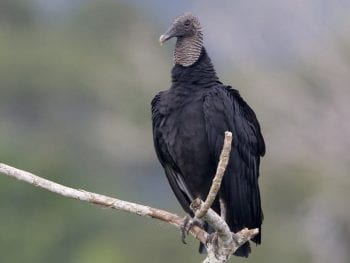
Juvenile © Brian Sullivan
Osprey (Pandion haliaetus):
Length – 24 Inches
Wingspan – 66 inches
Ospreys found in Missouri are typically migrating between Canada and the southern United States. Osprey eat almost exclusively fish and are able to carry off prey that weigh as much as they do, upwards of 4 pounds. In the 1950s and 60s, pesticides in the waterways led to a huge crash in Osprey population. Chemicals in these pesticides caused Osprey eggshells to thin, leading to low birth rates (All About Birds) Conservation efforts were made in the 1990s, limiting pesticide use, and Ospreys are now off the endangered list. In flight, the osprey prefers to keep its wings close to it rather than outstretched; this gives it greater maneuverability at the cost of efficiency. From above, their wings are dark brown but they have a white underbelly to blend in with the sky from below (Tekiela 45, 2001).
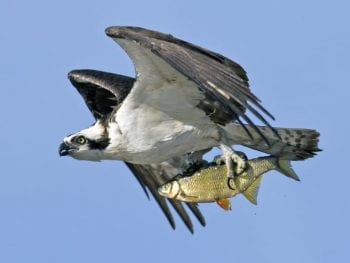
Osprey Adult Carrying Fish ©David Brown

Osprey Adult © Kris Perlberg
Bald Eagle (Haliaeetus leucocephalus):
Length – 36 Inches
Wingspan – 84 Inches
The national bird is best known for its white head and tail, brown body and large yellow beak. In flight, bald eagles hold their wings straight and flat, and, like most eagles, are very powerful flyers. They are found state-wide but return to their breeding grounds in the northern United States in the Spring. Their nests are typically 7 ft across and 10 ft deep, made out of sticks from sycamores, cottonwoods, and bald cypress trees (All About Birds). Bald eagles feed primarily on fish but also consume mussels, crayfish, rabbits, and turtles, which explains why they are most often found near bodies of water. The Juvenile Bald Eagle looks significantly different, not sporting the characteristic white head and having mottled grey feathers. (Tekiela 47, 2001)
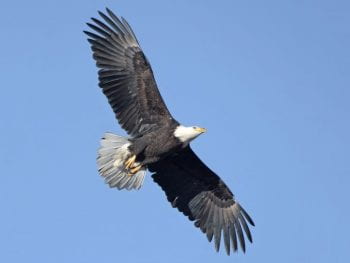
Bald Eagle Adult © Steven Mlodinow
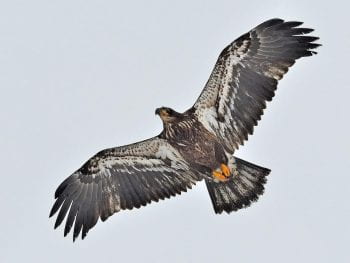
Bald Eagle Juvenile © Nina Stavlund & Tony Beck
Golden Eagle (Aquila chrysaetos):
Length – 37 Inches
Wingspan – 86 Inches
Golden eagles are only found during the winter in small numbers. They are easily recognizable due to their immense wingspan, brown body and golden sheen on their feathers throughout the body and head. Golden eagles fly similarly to turkey vultures, with their wings slightly raised. They feed on a variety of prey, small mammals and birds in open grasslands. (Raptors of the World)
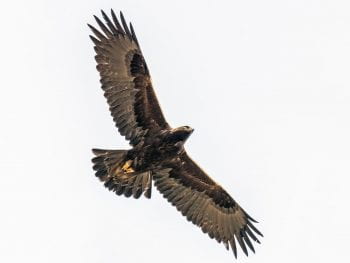
Golden Eagle Adult ©Jeff Bleam
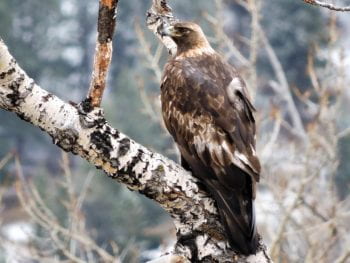
Taiga Morph © Daniel Casey
Mississippi Kite (Ictinia mississippiensis):
Length – 15 inches
Wingspan – 36 inches
The Kite’s flight pattern is very different from other raptors in that it performs swallow-like gliding and diving to eat insects and other small birds. They are highly territorial, and when nesting in suburban trees, will often attack human passerby. Mississippi kites can be found in Missouri in the summer and mostly in the southeastern parts of Missouri. They have a light gray body, with a whitish head and a black tail. (Tekiela 209, 2001)
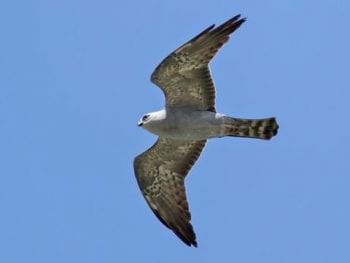

Juvenile © Chris Davis
Northern Harrier (Cicus cyaneus):
Length – 18-22 inches
Wingspan – 40-47 inches
Otherwise known as the marsh hawk, the Northern Harrier is typically found soaring low over prairies, marches and hay fields in the winter. Since there is little native prairie or open wetlands they are rather uncommon. They hunt rodents, birds, insects, snakes, etc. (All About Birds) Males have a gray upper and white underbelly while females are brown and streaked below. Their disc-shaped face helps them locate prey by sound, and they are one of few raptors to nest on the ground and lay four to seven eggs. Males have grey feathers and black wingtips, while females are brown. (Tekiela 213, 2001)
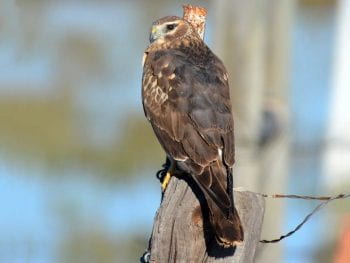
Northern Harrier Adult Female ©Dan Murphy
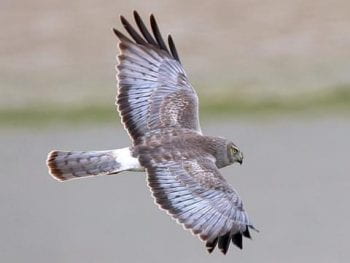
Adult Male ©Tim Avery
Swainson’s Hawk (Buteo swainsoni):
Length – 21 inches
Wingspan – 52 inches
They are typically found in South America during the winter and western United States in the summer but occasionally seen in western Missouri in the warm months. They are distinguished by their relatively slim body, dark chestnut breast, and all-brown back feathers. Their underbellies have white wing linings and darker, barred wings. It hunts for rodents, birds snakes, insects etc. over prairies and crop fields by circling like a vulture. (Raptors of the World)

Swainson’s Hawk Adult ©Brian Rusnica
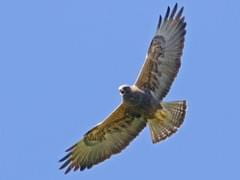
© Ed Harper
Red-Tailed Hawk (Buteo jamaicensis):
Length – 22 Inches
Wingspan – 50 inches
The red-tailed hawk is found all over North America. They are easy to identify with their brown upper and nearly uniformly white/light streaked underbelly and namesake reddish tails. They have aggressive hunting abilities, the soar above open fields lowly turning circles on their broad, rounded wings. (All About Birds) Red-Tailed Hawks are the largest species of hawk and hunt more like Eagles than other types of Hawk. They prefer to use their size and speed to hunt larger prey than the smaller yet more agile hawks. (Tekiela 157, 2001)

Red-tailed Hawk Adult ©Andrew Spencer
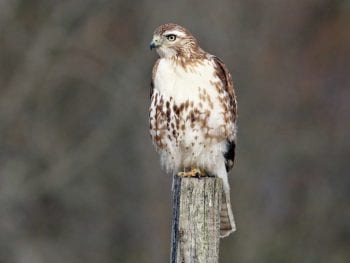
Red-tailed Hawk Juvenile Tundra Morph ©Jonathan Eckerson
Red-Shouldered Hawk (Buteo lineatus):
Length – 19 inches
Wingspan – 40 inches
The Red-shouldered hawk has a unique call of KEyar- KEyar- KEyar. They nest and feed along forested streams and rivers of the Ozarks and Mississippi lowlands, but can be found throughout the state. They have black and white barring on their wings and tails and rounded wing tips and rusty shoulders. (Raptors of the World)
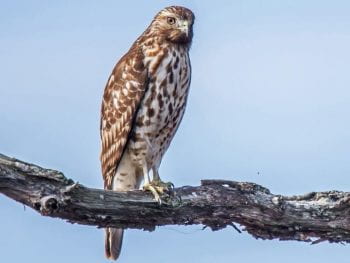
Red-shouldered Hawk Juvenile ©Ed Wransky
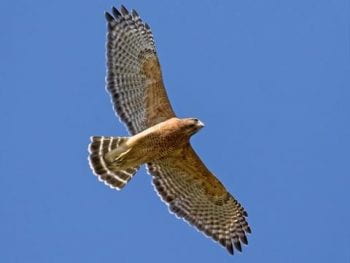
Adult ©Chris Wood
Broad-Winged Hawk (Buteo Platypterus):
Length – 16 inches
Wingspan – 33 inches
Especially found in the Ozarks and Ozark Border regions, but are more commonly found during migration. Their underside is light-colored, with tapered and pointed black wings. They are one of few raptors that flock during migration, in groups of thousands of birds (All About Birds).
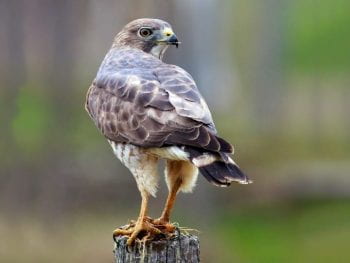
Broad-winged Hawk Adult ©Andrew Aldrich
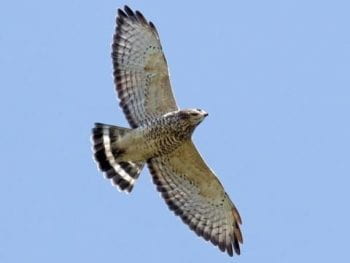
Broad-Winged Hawk Adult ©David Brown
Rough-Legged Hawk (Buteo lagopus):
Length – 22 inches
Wingspan – 56 inches
Often nest on cliffs in the far northern Arctic, but can be seen in Missouri during the winter due to Migration. In Missouri, they hunt in open grassland and crop fields, soaring with their long wings slightly uptilted. They are a light and dark color morph all around, with tail bands (All About Birds).
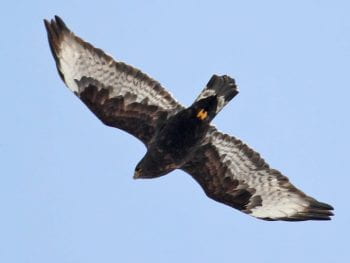
Rough-legged Hawk Adult Dark morph ©Skye Haas
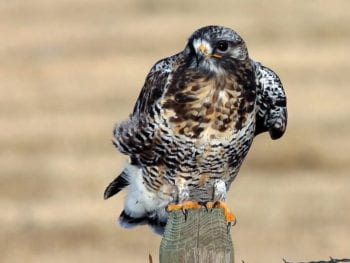
Rough-legged Hawk Adultl Light morph © Shawn Billerman
Sharp-Shinned Hawk (Accipitier striatus):
Length – 11-14 inches
Wingspan – 22-28 inches
The Sharp-Shinned hawk is one of the smallest species of Hawk. It has rounded wings and a long, rounded tail. These features allow their bodies to weave in and out of tree branches when chasing after prey. They have a slate gray head and neck and brown and white barring underbelly. They rarely reside in Missouri year-round and are found during their migration in the winter (Tekiela 205, 2001).
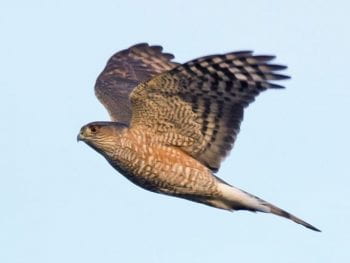
Sharp-shinned Hawk Adult ©Alix d’Entremont
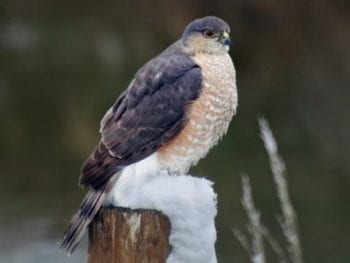
Juvenile, Taiga Morph ©Robert Beauchamp
Cooper’s Hawk (Accipitier cooperii):
Length – 15-18 inches
Wingspan – 30-36 inches
Cooper’s hawks reside in Missouri year-round. They mainly hunt in forests but can be found in urban areas as well. Cooper’s have blue-gray wings above and horizontal, rusty barring on the underbelly. They also have a rounded tip that is black and white. Note- Eye changes color from yellow to dark red as the individual matures (Tekiela 211, 2001).
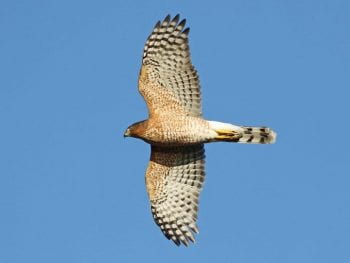
Cooper’s Hawk Adult ©Alex Lamoreaux
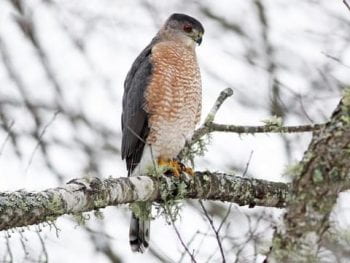
Juvenile, Taiga Morph ©Evan Lipton
Northern Goshawk (Accipiter gentilis):
Length – 21-25 inches
Wingspan – 40-46 inches
The northern goshawk lives year-round in the United States but only during Winter in Missouri. They hunt in hedgerows, along tree lines and sometimes in urban areas. They are defensive of their nests and have been known to attack people that approach it. In flight, their wing tips appeared more tapered, giving them incredible agility when hunting. Their distinguishing feature is the white eyebrow above their relatively grey head and body (All About Birds).

Northern Goshawk Juvenile ©Brian Sullivan
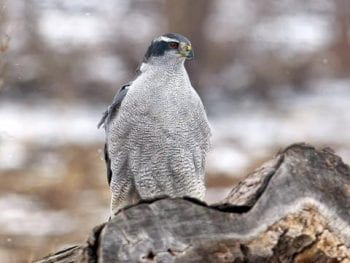
Adult, Taiga Morph ©Paul Roisen
American Kestrel (Falco sparverius):
Length – 9-11 inches
Wingspan – 20-23 inches
Formerly known as the sparrow hawks, American kestrels are the most common falcon in North America. They reside year-round in Missouri both in open countryside and urban areas but are more likely to be found in the spring and fall. Rather than soaring and gliding, the American Kestrel hoverings while hunting (All About Birds). Being the smallest of the American Birds of prey, the kestrel hunts insects and is often eaten by other larger birds of prey. They have a bright rusty back and tail, bluish-black wings, orange-brown breast, blue and rusty head, and a brown barring on the neck. They tend to nest in cavities, in caves, and buildings rather than atop trees or cliffs like most raptors (Tekiela 135, 2001).

American Kestrel Female ©Noah Frade
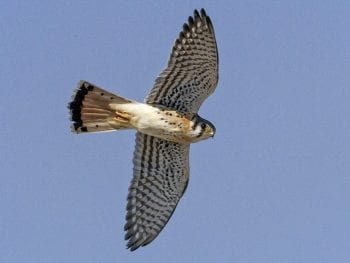
American Kestrel Male ©Jacob Drucker
Peregrine Falcon (Falco peregrinus):
Length – 15-21 inches
Wingspan – 38-45 inches
Peregrines are the fastest living animal. They can dive up to speeds of 200 miles per hour. They are uniformly white and dark narrow-barred below and gray-blue above. They are found worldwide but are very uncommon in Missouri (All About Birds). The last known citing of a peregrine in Missouri was in 1911 but they have been reintroduced to the area over the course of the past two decades. Peregrines are common in cities, where they can hunt abundant pigeons and use the buildings to dive on their prey (Raptors of the World).
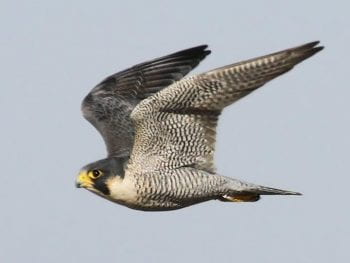
Peregrine Falcon Adult ©Ryan Schain
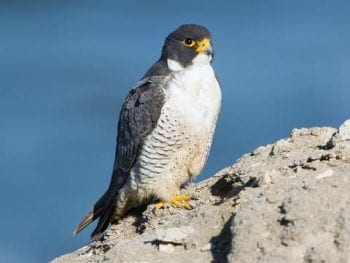
Juvenile ©Dorian Anderson
Merlin (Falco columbarius):
Length – 10-12 inches
Wingspan – 22-25 inches
Merlins are found during the winter months in Missouri although it is rather uncommon. They have blue-gray above and white/brown streaks below and contain a light eyebrow and a dark tail and narrow light bands. Merlins fly low over the ground in a zig-zag pattern with rapid wing beats. They often chase flocks of birds and capture the weakest bird, but they also forage for prey in the grasslands and crop fields.
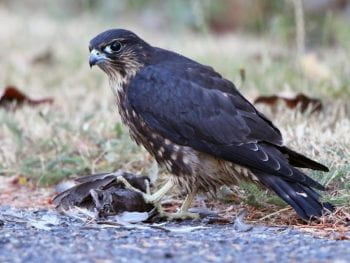
Merlin Adult (Black) ©Ryan Merrill

©Joel Trick
Prairie Falcon (Falco mexicanus):
Length – 16-19 inches
Wingspan – 38-43 inches
Prairie falcons have light wings and with darker markings at their wing bases. They are known to be aggressive and harass larger hawks and eagles however they prey upon smaller birds and animals by flying rapidly close to the ground. Also rarely found raptor but if seen it is typically found in the northwest parts of Missouri. Prairie falcons around found throughout the western United States and southern Canada but occasionally can be found in floodplains and open grasslands in winter. Davit, Carol. “Missouri’s Raptors.” Missouri Conservationalist. (Jan. 2009): 1-17
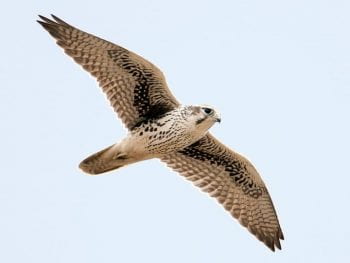
Prairie Falcon Juvenile ©Ian Routley
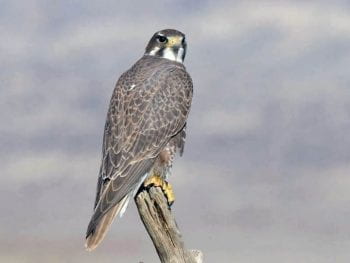
Prairie Falcon Adult ©Greg Gillson
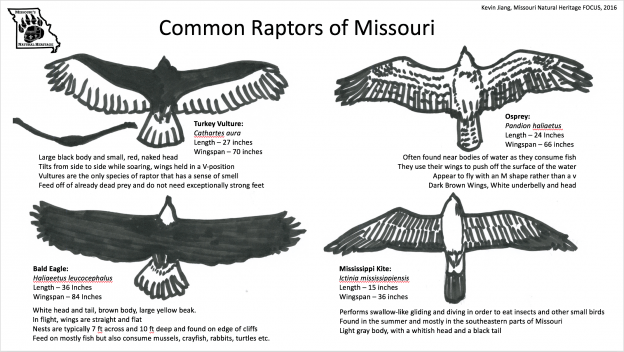
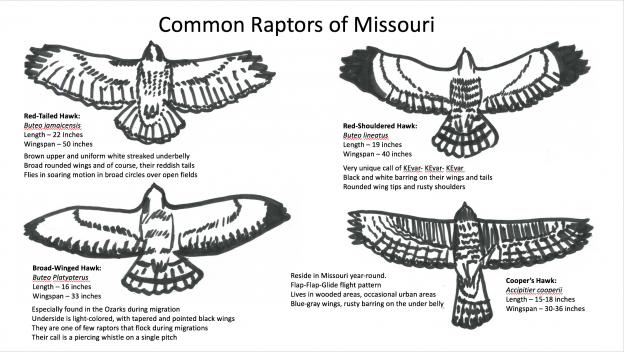
Resources
Davit, Carol. “Missouri’s Raptors.” Missouri Conservationalist. (Jan. 2009): 1-17
“Project Beak: Adaptations: Senses: Ears.” Project BEAK. Education Workgroup of the Nebraska Bird Partnership, n.d. Web. 05 Oct. 2016.
“Raptors of the World.” raptorresearchfoundation.org. Raptor Research Foundation, 2015. Web. 7 Oct. 2015
Snyder, Noel F. R., and Helen A. Snyder. Birds of Prey: Natural History and Conservation of North American Raptors. St. Paul, MN: Peregrine Publications, 1991. Print
Sibley, D. A. (2014). The Sibley guide to birds, second edition. Alfred A. Knopf, New York, USA.
Stan Tekiela (2001). Birds of Missouri, Field Guide. Adventure Publications, Minnesota, USA.
All photos retrieved from allaboutbirds.org, used in agreement with their educational use policy
Sibley, D. A. (2014). The Sibley guide to birds, second edition. Alfred A. Knopf, New York, USA.
Stan Tekiela (2001). Birds of Missouri, Field Guide. Adventure Publications, Minnesota, USA.
Photo of black vulture from https://nationalzoo.si.edu/scbi/migratorybirds/featured_photo/bird.cfm?pix=Black+Vulture
Sibley, D. A. (2014). The Sibley guide to birds, second edition. Alfred A. Knopf, New York, USA.
Stan Tekiela (2001). Birds of Missouri, Field Guide. Adventure Publications, Minnesota, USA.